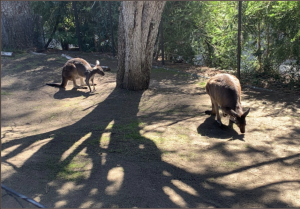The San Diego Zoo has an exhibit with closed gates and a walkway. In the exhibit, there’s a gate where you can walk in to get a closer look at the animals. While walking along, there’s a sign talking about marsupials.

Wildlife care specialist Sarah says “The kangaroos live in an incredible habitat that is very similar to their native habitat in Australia. It is about three acres in size and has a stream and a pond that runs down the middle. There are tons of bushes and trees as well as grass that are all edible for the kangaroos.”
When asked about a kangaroo’s personality, wildlife care specialist Sarah states “They are so full of personality and can be incredibly funny and sweet. They’re also known for being very stubborn, which I find amusing.”
Did you know there’s twice the number of kangaroos than people in Australia and can also use their tail as a third leg?
The kangaroo can have different fur colors: red, grey, light, or dark brown. They use their long tails as a third leg to keep them balanced. They also use their hind legs to hop quickly through savannas and forests.
Kangaroos are macropods, which means “big feet.” In the Macropod family, it consists of more than 50 other species. Kangaroos, wallaroos, quokkas, wallabies, potoroos, honey possums, and tree kangaroos just to name a few.
Marsupial fetuses are not fully developed when they’re born. They crawl out of their mother and into their mother’s pouch. They have pouches where the underdeveloped baby goes. They stay in the pouch for around 8 months.
There are different names for female and male kangaroos. For females, they are referred to as a doe, a jill, or a roo. For males, it’s buck, boomer, jack, and old man.
Their life span usually ranges from 7 to 18 years and they can grow up to 7ft tall. They can also weigh between 48 to 187 pounds.